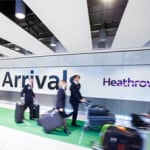
Both Schiphol Airport in The Netherlands and Zurich Airport, Switzerland, have been benefiting immensely from the great efficiencies enabled from new baggage and security screening technology. Schipol Airport in particular is reported to be able to process three times the passengers through screening than they were able to achieve previously.
The new technologies that have enhanced baggage check-in use automation, one of the most beneficial advances in airport security screening and baggage handling that we have experienced recently.
For baggage drop off at Check-in, the turnkey BagDrop system, in use in Schiphol and Zurich, uses automation and the passenger themselves to drive the process. The passenger places their luggage in a self-service BagDrop unit and scans their boarding pass. A self-adhesive baggage label is then printed that the passenger attaches to the item.
When the passenger has confirmed that the label is attached, the system checks the baggage item for weight, dimensions, shape, presence of the right baggage label, takes photographs and positions the bag in its most stable position.
If the item is overweight, a charge is automatically calculated and payment made by debit or credit card. The passenger then receives a printed claim ticket for arrivals and the item is passed through to the standard baggage handling system. Through this system, the passenger is in charge of this self-service process, all details are collected and transferred automatically, and the check-in times are reduced.
Amsterdam’s Schiphol airport is also using a new auto scan system during security screening. When passengers queue for security screening and to place their hand luggage on a tray, automation and screening technology is used to speed up the process. The screening unit performs an initial assessment of the content of the tray, and only shows the operator an image when it spots a suspicious item. The operator has fewer images to check, and more time to concentrate on the images that do require attention.
Hand luggage that requires further checks splits from the stream of approved trays, and goes through another screening unit at the end of the lane. This means that they do not have to return to the original line for X-Rays, creating even further efficiencies.
Through AiQ Consulting’s own work with Heathrow and Manchester Airports, we are following these new technologies with great interest. Have a look at our case studies for more of the work we do in increasing efficiencies and airport capacity planning for airports and airport operators around the world.

